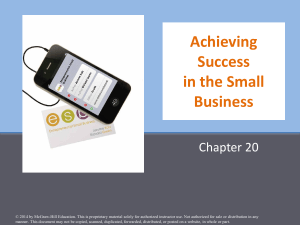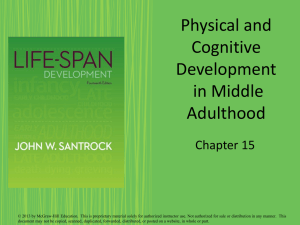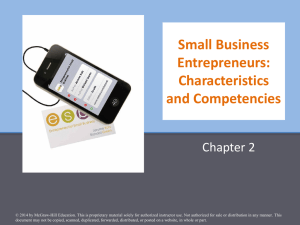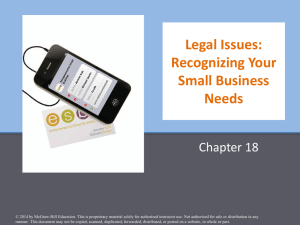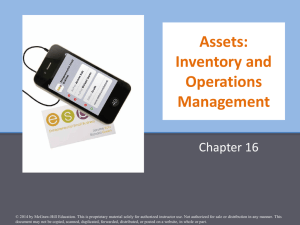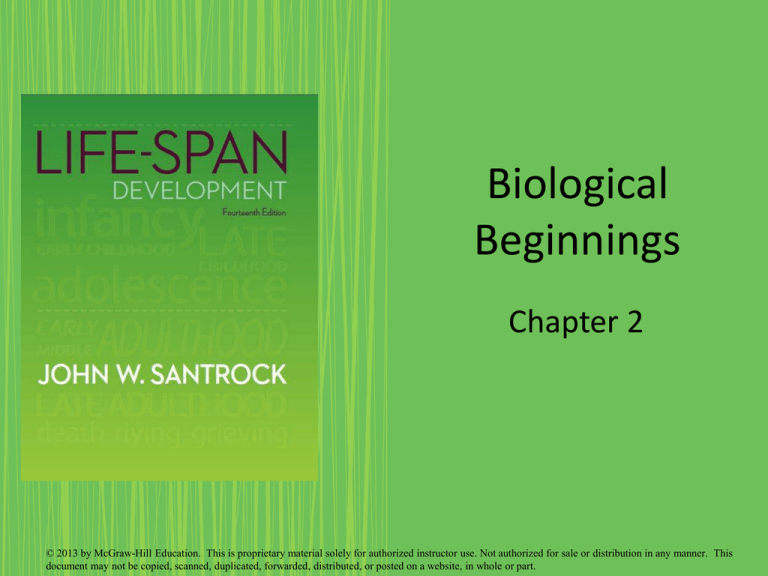
Biological
Beginnings
Chapter 2
© 2013 by McGraw-Hill Education. This is proprietary material solely for authorized instructor use. Not authorized for sale or distribution in any manner. This
document may not be copied, scanned, duplicated, forwarded, distributed, or posted on a website, in whole or part.
Chapter Outline
•
•
•
•
The evolutionary perspective
Genetic foundations of development
Reproductive challenges and choices
Heredity-environment interaction: The naturenurture debate
2-2
© 2013 by McGraw-Hill Education. This is proprietary material solely for authorized instructor use. Not authorized for sale or distribution in any manner. This
document may not be copied, scanned, duplicated, forwarded, distributed, or posted on a website, in whole or part.
The Evolutionary Perspective
• Natural selection and adaptive behavior
• Evolutionary psychology
2-3
© 2013 by McGraw-Hill Education. This is proprietary material solely for authorized instructor use. Not authorized for sale or distribution in any manner. This
document may not be copied, scanned, duplicated, forwarded, distributed, or posted on a website, in whole or part.
Natural Selection and Adaptive
Behavior
• Natural selection - Evolutionary process by
which those individuals of a species that are
best adapted are the ones that survive and
reproduce
• Adaptive behavior - Promotes an organism’s
survival in the natural habitat
2-4
© 2013 by McGraw-Hill Education. This is proprietary material solely for authorized instructor use. Not authorized for sale or distribution in any manner. This
document may not be copied, scanned, duplicated, forwarded, distributed, or posted on a website, in whole or part.
Evolutionary Psychology
• Emphasizes the importance of adaptation,
reproduction, and survival of the fittest in
shaping behavior
• Evolutionary developmental psychology
– Interest has grown in using the concepts of
evolutionary psychology to understand human
development
– Psychological mechanisms are domain-specific
2-5
© 2013 by McGraw-Hill Education. This is proprietary material solely for authorized instructor use. Not authorized for sale or distribution in any manner. This
document may not be copied, scanned, duplicated, forwarded, distributed, or posted on a website, in whole or part.
Evolutionary Psychology
• Connecting evolution and life-span
development
– Benefits conferred by evolutionary selection
decrease with age
– Natural selection primarily operates during the
first half of life
2-6
© 2013 by McGraw-Hill Education. This is proprietary material solely for authorized instructor use. Not authorized for sale or distribution in any manner. This
document may not be copied, scanned, duplicated, forwarded, distributed, or posted on a website, in whole or part.
Evolutionary Psychology
– Older adults
• Weaken biologically
• Need culture-based resources
– Cognitive skills, literacy, medical technology, and social
support
2-7
© 2013 by McGraw-Hill Education. This is proprietary material solely for authorized instructor use. Not authorized for sale or distribution in any manner. This
document may not be copied, scanned, duplicated, forwarded, distributed, or posted on a website, in whole or part.
Figure 2.2 - Baltes’ View of Evolution and
Culture Across the Life Span
2-8
© 2013 by McGraw-Hill Education. This is proprietary material solely for authorized instructor use. Not authorized for sale or distribution in any manner. This
document may not be copied, scanned, duplicated, forwarded, distributed, or posted on a website, in whole or part.
Evolutionary Psychology
• Evaluation
– Evolution gave us biological potentialities but it
does not dictate behavior
– People have used their biological capacities to
produce diverse cultures
• Aggressive and peace-loving, egalitarian and autocratic
– Studying specific genes in humans and other
species and their links to traits and behaviors
• Best approach for testing ideas coming out of
evolutionary psychology
2-9
© 2013 by McGraw-Hill Education. This is proprietary material solely for authorized instructor use. Not authorized for sale or distribution in any manner. This
document may not be copied, scanned, duplicated, forwarded, distributed, or posted on a website, in whole or part.
Genetic Foundations of Development
•
•
•
•
The collaborative gene
Genes and chromosomes
Genetic principles
Chromosomal and gene-linked abnormalities
2 - 10
© 2013 by McGraw-Hill Education. This is proprietary material solely for authorized instructor use. Not authorized for sale or distribution in any manner. This
document may not be copied, scanned, duplicated, forwarded, distributed, or posted on a website, in whole or part.
The Collaborative Gene
• Human life begins as a single cell
• Nucleus of each cell contains chromosomes
– Chromosomes: Threadlike structures made up of
deoxyribonucleic acid
– DNA: A complex double-helix molecule that
contains genetic information
• Genes: Units of hereditary information, are
short segments of DNA
2 - 11
© 2013 by McGraw-Hill Education. This is proprietary material solely for authorized instructor use. Not authorized for sale or distribution in any manner. This
document may not be copied, scanned, duplicated, forwarded, distributed, or posted on a website, in whole or part.
Figure 2.3 - Cells, Chromosomes, DNA,
and Genes
2 - 12
© 2013 by McGraw-Hill Education. This is proprietary material solely for authorized instructor use. Not authorized for sale or distribution in any manner. This
document may not be copied, scanned, duplicated, forwarded, distributed, or posted on a website, in whole or part.
The Collaborative Gene
• Genome-wide association method - Identify
genetic variations linked to a particular
disease
• Human genome consists of many genes that
collaborate:
– Both with each other and with nongenetic factors
inside and outside the body
2 - 13
© 2013 by McGraw-Hill Education. This is proprietary material solely for authorized instructor use. Not authorized for sale or distribution in any manner. This
document may not be copied, scanned, duplicated, forwarded, distributed, or posted on a website, in whole or part.
The Collaborative Gene
• Activity of genes is affected by their
environment
• Stress, radiation, and temperature can
influence gene expression
• Exposure to radiation changed the rate of DNA
synthesis in cells
2 - 14
© 2013 by McGraw-Hill Education. This is proprietary material solely for authorized instructor use. Not authorized for sale or distribution in any manner. This
document may not be copied, scanned, duplicated, forwarded, distributed, or posted on a website, in whole or part.
Genes and Chromosomes
• Mitosis, meiosis, and fertilization
– Mitosis: Reproduction of cells
– Meiosis: Cell division that forms sperm and eggs
(gametes)
– Fertilization: A stage in reproduction when an egg
and a sperm fuse to create a single cell, called a
zygote
• Zygote: A single cell formed through fertilization
2 - 15
© 2013 by McGraw-Hill Education. This is proprietary material solely for authorized instructor use. Not authorized for sale or distribution in any manner. This
document may not be copied, scanned, duplicated, forwarded, distributed, or posted on a website, in whole or part.
Figure 2.5 - The Genetic Difference
Between Males and Females
2 - 16
© 2013 by McGraw-Hill Education. This is proprietary material solely for authorized instructor use. Not authorized for sale or distribution in any manner. This
document may not be copied, scanned, duplicated, forwarded, distributed, or posted on a website, in whole or part.
Genes and Chromosomes
• Sources of variability
– Combining the genes of two parents in off spring
increases genetic variability
– Identical twins (monozygotic twins)
• Develop from a single zygote that splits into two
genetically identical replicas, each of which becomes a
person
2 - 17
© 2013 by McGraw-Hill Education. This is proprietary material solely for authorized instructor use. Not authorized for sale or distribution in any manner. This
document may not be copied, scanned, duplicated, forwarded, distributed, or posted on a website, in whole or part.
Genes and Chromosomes
– Fraternal twins (dizygotic twins)
• Develop when two eggs are fertilized by different
sperm, creating two zygotes that are genetically no
more similar than ordinary siblings
2 - 18
© 2013 by McGraw-Hill Education. This is proprietary material solely for authorized instructor use. Not authorized for sale or distribution in any manner. This
document may not be copied, scanned, duplicated, forwarded, distributed, or posted on a website, in whole or part.
Genes and Chromosomes
– Mutated gene - Permanently altered segment of
DNA
– Susceptibility genes - Make the individual more
vulnerable to specific diseases or accelerated
aging
– Longevity genes - Make the individual less
vulnerable to certain diseases and more likely to
live to an older age
2 - 19
© 2013 by McGraw-Hill Education. This is proprietary material solely for authorized instructor use. Not authorized for sale or distribution in any manner. This
document may not be copied, scanned, duplicated, forwarded, distributed, or posted on a website, in whole or part.
Genes and Chromosomes
– Genotype: Genetic heritage
– Phenotype: Way an individual’s genotype is
expressed in observed and measurable
characteristics
2 - 20
© 2013 by McGraw-Hill Education. This is proprietary material solely for authorized instructor use. Not authorized for sale or distribution in any manner. This
document may not be copied, scanned, duplicated, forwarded, distributed, or posted on a website, in whole or part.
Genetic Principles
• Dominant-recessive genes principle
– One gene of a pair always exerts its effects
(dominant), overriding the potential influence of
the other gene (recessive)
• Sex-linked genes
– When a mutated gene is carried on the X
chromosome, the result is called X-linked
inheritance
2 - 21
© 2013 by McGraw-Hill Education. This is proprietary material solely for authorized instructor use. Not authorized for sale or distribution in any manner. This
document may not be copied, scanned, duplicated, forwarded, distributed, or posted on a website, in whole or part.
Genetic Principles
• Genetic imprinting
– Occurs when the expression of a gene has
different effects depending on whether the
mother or the father passed on the gene
2 - 22
© 2013 by McGraw-Hill Education. This is proprietary material solely for authorized instructor use. Not authorized for sale or distribution in any manner. This
document may not be copied, scanned, duplicated, forwarded, distributed, or posted on a website, in whole or part.
Genetic Principles
• Polygenic inheritance
– Polygenically determined - Determined by the
interaction of many different genes
– Gene-gene interaction - Studies that focus on the
interdependence of two or more genes in:
• Influencing characteristics, behavior, diseases, and
development
2 - 23
© 2013 by McGraw-Hill Education. This is proprietary material solely for authorized instructor use. Not authorized for sale or distribution in any manner. This
document may not be copied, scanned, duplicated, forwarded, distributed, or posted on a website, in whole or part.
Figure 2.6 - Some Chromosomal
Abnormalities
2 - 24
© 2013 by McGraw-Hill Education. This is proprietary material solely for authorized instructor use. Not authorized for sale or distribution in any manner. This
document may not be copied, scanned, duplicated, forwarded, distributed, or posted on a website, in whole or part.
Gene-Linked Abnormalities
• Phenylketonuria (PKU)
– Metabolic disorder that, left untreated, causes
mental retardation
• Sickle-cell anemia
– Blood disorder that limits the body’s oxygen
supply
– Can cause joint swelling, as well as heart and
kidney failure
2 - 25
© 2013 by McGraw-Hill Education. This is proprietary material solely for authorized instructor use. Not authorized for sale or distribution in any manner. This
document may not be copied, scanned, duplicated, forwarded, distributed, or posted on a website, in whole or part.
Gene-Linked Abnormalities
• Cystic fibrosis
– Glandular dysfunction that interferes with mucus
production
– Breathing and digestion are hampered, resulting
in a shortened life span
• Diabetes
– Body does not produce enough insulin, which
causes abnormal metabolism of sugar
2 - 26
© 2013 by McGraw-Hill Education. This is proprietary material solely for authorized instructor use. Not authorized for sale or distribution in any manner. This
document may not be copied, scanned, duplicated, forwarded, distributed, or posted on a website, in whole or part.
Gene-Linked Abnormalities
• Hemophilia
– Delayed blood clotting causes internal and
external bleeding
• Huntington’s disease
– Central nervous system deteriorates, producing
problems in muscle coordination and mental
deterioration
2 - 27
© 2013 by McGraw-Hill Education. This is proprietary material solely for authorized instructor use. Not authorized for sale or distribution in any manner. This
document may not be copied, scanned, duplicated, forwarded, distributed, or posted on a website, in whole or part.
Gene-Linked Abnormalities
• Spina bifida
– Neural tube disorder that causes brain and spine
abnormalities
• Tay-Sachs disease
– Deceleration of mental and physical development
caused by an accumulation of lipids in the nervous
system
2 - 28
© 2013 by McGraw-Hill Education. This is proprietary material solely for authorized instructor use. Not authorized for sale or distribution in any manner. This
document may not be copied, scanned, duplicated, forwarded, distributed, or posted on a website, in whole or part.
Dealing with Genetic Abnormalities
• Every individual carries DNA variations that
might predispose the person to serious
physical disease or mental disorder
• Genes that are missing, nonfunctional, or
mutated can be associated with disorders
• Knowledge of genetic flaws might bring
important costs as well as benefits
2 - 29
© 2013 by McGraw-Hill Education. This is proprietary material solely for authorized instructor use. Not authorized for sale or distribution in any manner. This
document may not be copied, scanned, duplicated, forwarded, distributed, or posted on a website, in whole or part.
Reproductive Challenges and Choices
• Prenatal diagnostic tests
• Infertility and reproductive technology
• Adoption
2 - 30
© 2013 by McGraw-Hill Education. This is proprietary material solely for authorized instructor use. Not authorized for sale or distribution in any manner. This
document may not be copied, scanned, duplicated, forwarded, distributed, or posted on a website, in whole or part.
Prenatal Diagnostic Tests
•
•
•
•
•
•
•
Ultrasound sonography
Brain imaging techniques
Chorionic villus sampling
Amniocentesis
Maternal blood screening
Noninvasive prenatal diagnosis (NIPD)
Fetal sex determination
2 - 31
© 2013 by McGraw-Hill Education. This is proprietary material solely for authorized instructor use. Not authorized for sale or distribution in any manner. This
document may not be copied, scanned, duplicated, forwarded, distributed, or posted on a website, in whole or part.
Infertility and Reproductive
Technology
• Infertility - Inability to conceive a child after
12 months of regular intercourse without
contraception
• In vitro fertilization (IVF) - Eggs and sperm are
combined in a laboratory dish
– Fertilized egg is transferred into the woman’s
uterus
• Success rate of IVF depends on the mother’s
age
2 - 32
© 2013 by McGraw-Hill Education. This is proprietary material solely for authorized instructor use. Not authorized for sale or distribution in any manner. This
document may not be copied, scanned, duplicated, forwarded, distributed, or posted on a website, in whole or part.
Adoption
• Social and legal process that establishes
parent-child relationship between persons
unrelated at birth
– Increased diversity of adopted children and
adoptive parents
– Outcomes for adopted children
• Adopted children fare much better than children raised
in long-term foster care
• Children who are adopted very early are more likely to
have positive outcomes
2 - 33
© 2013 by McGraw-Hill Education. This is proprietary material solely for authorized instructor use. Not authorized for sale or distribution in any manner. This
document may not be copied, scanned, duplicated, forwarded, distributed, or posted on a website, in whole or part.
Heredity-Environment Interaction:
The Nature-Nurture Debate
• Behavior genetics
• Heredity-environment correlations
• Shared and nonshared environmental
experiences
• The epigenetic view and gene x environment
(g x e) interaction
• Conclusions about heredity-environment
interaction
2 - 34
© 2013 by McGraw-Hill Education. This is proprietary material solely for authorized instructor use. Not authorized for sale or distribution in any manner. This
document may not be copied, scanned, duplicated, forwarded, distributed, or posted on a website, in whole or part.
Behavior Genetics
• Seeks to discover the influence of heredity
and environment on individual differences in
human traits and development
– Twin study: Behavioral similarity of identical and
fraternal twins is compared
2 - 35
© 2013 by McGraw-Hill Education. This is proprietary material solely for authorized instructor use. Not authorized for sale or distribution in any manner. This
document may not be copied, scanned, duplicated, forwarded, distributed, or posted on a website, in whole or part.
Behavior Genetics
– Adoption study: Seek to discover whether, in
behavior and psychological characteristics,
adopted children are:
• More like their adoptive parents, who provided a home
environment
• More like their biological parents, who contributed
their heredity
2 - 36
© 2013 by McGraw-Hill Education. This is proprietary material solely for authorized instructor use. Not authorized for sale or distribution in any manner. This
document may not be copied, scanned, duplicated, forwarded, distributed, or posted on a website, in whole or part.
Figure 2.11 - Exploring HeredityEnvironment Correlations
2 - 37
© 2013 by McGraw-Hill Education. This is proprietary material solely for authorized instructor use. Not authorized for sale or distribution in any manner. This
document may not be copied, scanned, duplicated, forwarded, distributed, or posted on a website, in whole or part.
Shared and Nonshared Environmental
Experiences
• Shared environmental experiences: Siblings’
common environmental experiences
– Their parents’ personalities and intellectual
orientation
– Family’s socioeconomic status
– Neighborhood in which they live
2 - 38
© 2013 by McGraw-Hill Education. This is proprietary material solely for authorized instructor use. Not authorized for sale or distribution in any manner. This
document may not be copied, scanned, duplicated, forwarded, distributed, or posted on a website, in whole or part.
Shared and Nonshared Environmental
Experiences
• Nonshared environmental experiences:
Child’s own unique experiences
– Both within the family and outside the family
– Not shared with another sibling
2 - 39
© 2013 by McGraw-Hill Education. This is proprietary material solely for authorized instructor use. Not authorized for sale or distribution in any manner. This
document may not be copied, scanned, duplicated, forwarded, distributed, or posted on a website, in whole or part.
Epigenetic View and Gene ×
Environment (G × E) Interaction
• Epigenetic view: Development is the result of
an ongoing, bidirectional interchange
between heredity and environment
2 - 40
© 2013 by McGraw-Hill Education. This is proprietary material solely for authorized instructor use. Not authorized for sale or distribution in any manner. This
document may not be copied, scanned, duplicated, forwarded, distributed, or posted on a website, in whole or part.
Figure 2.12 - Comparison of The Heredity Environment Correlation and Epigenetic Views
2 - 41
© 2013 by McGraw-Hill Education. This is proprietary material solely for authorized instructor use. Not authorized for sale or distribution in any manner. This
document may not be copied, scanned, duplicated, forwarded, distributed, or posted on a website, in whole or part.
Heredity-Environment Interaction:
The Nature-Nurture Debate
• Gene × environment (G × E) interaction:
Interaction of:
– Specific measured variation in the DNA
– Specific measured aspect of the environment
2 - 42
© 2013 by McGraw-Hill Education. This is proprietary material solely for authorized instructor use. Not authorized for sale or distribution in any manner. This
document may not be copied, scanned, duplicated, forwarded, distributed, or posted on a website, in whole or part.


